Assessment Of Energy Potential Of Biogas From Ongata Rongai Slaughter House

View/
Date
2015-01Author
Kirimi, Nazarene K
Type
ThesisLanguage
enMetadata
Show full item recordAbstract
This study focused on quantifying the amount of waste generated at Ongata Rongai slaughterhouse in order to identify a better way of disposal. Generation of biogas was explored in the study in relation to meeting the cooking energy needs of the neighbouring Sinai Hospital. The slaughter house currently spends Ksh.2,800.00 fortnightly to dispose the waste produced during the slaughtering process which includes the stomach and intestinal contents. Manure collects in the animal holding area/pen and waste water is channelled to soak pits that occupy more than half an acre of land. The neighbouring Sinai hospital uses 30kg of LPG for cooking in a month at a cost of Ksh.7,000.00. In order to quantify the amount of energy potential of the slaughterhouse, records of the number of animals slaughtered in the month of February 2014 were obtained and the amount of waste expected at the slaughterhouse estimated at 458.9kg/day. The biogas digester was sized, designed and bill of quantities generated with an estimated cost of Ksh.393,813.20. Information on the energy used in the Hospital for cooking was obtained through interviews with the Hospital and from electricity consumption records. The amount of biogas that could be generated from the slaughterhouse was 495m3/month, equivalent to 10,890MJ/month and enough to provide for cooking needs of the Hospital and about 33 households. To encourage use of biogas from the slaughterhouse, an affordable tariff was worked out. This tariff would make use of biogas to be preferred to other cooking energy sources like LPG, charcoal or electricity. Two tariffs were derived as Ksh1.95/m3 and ksh21.84/m3 for payback periods of 5 and 2 years respectively.
vi
By venturing into biogas production, the slaughter house would generate income, save ksh2,800.00 fortnightly from eliminating hired services and improve the general hygiene of the slaughterhouse.
Publisher
University of Nairobi
